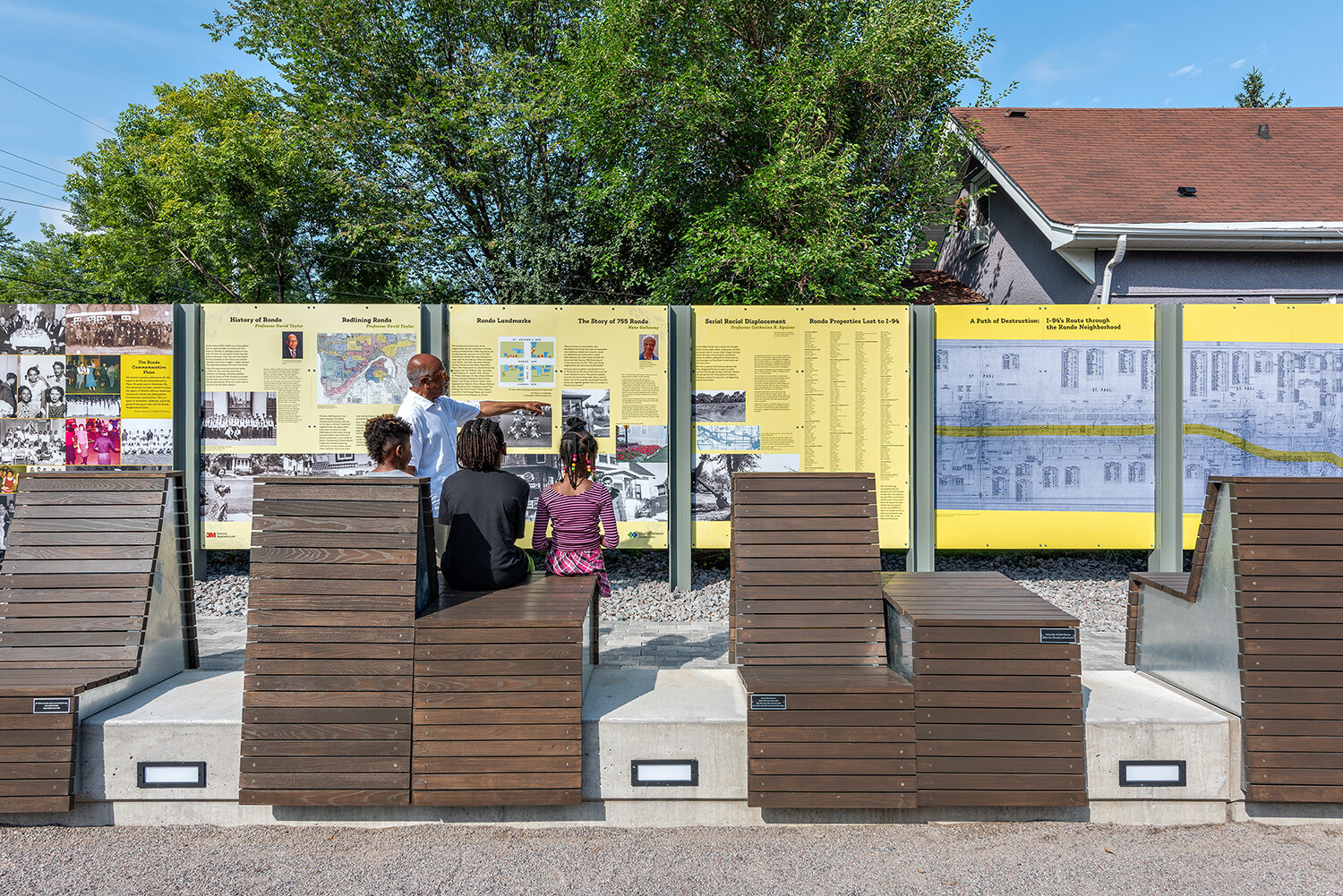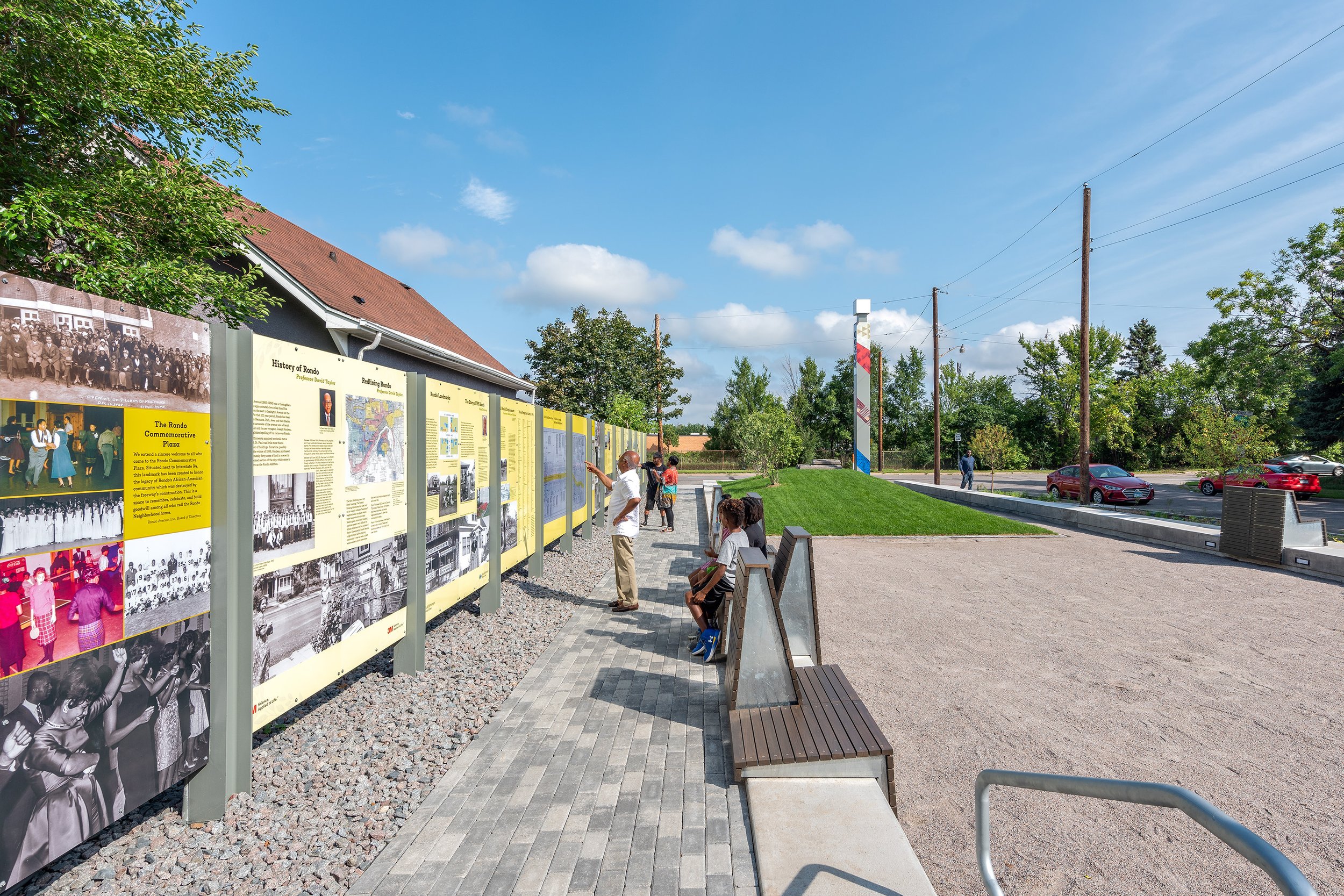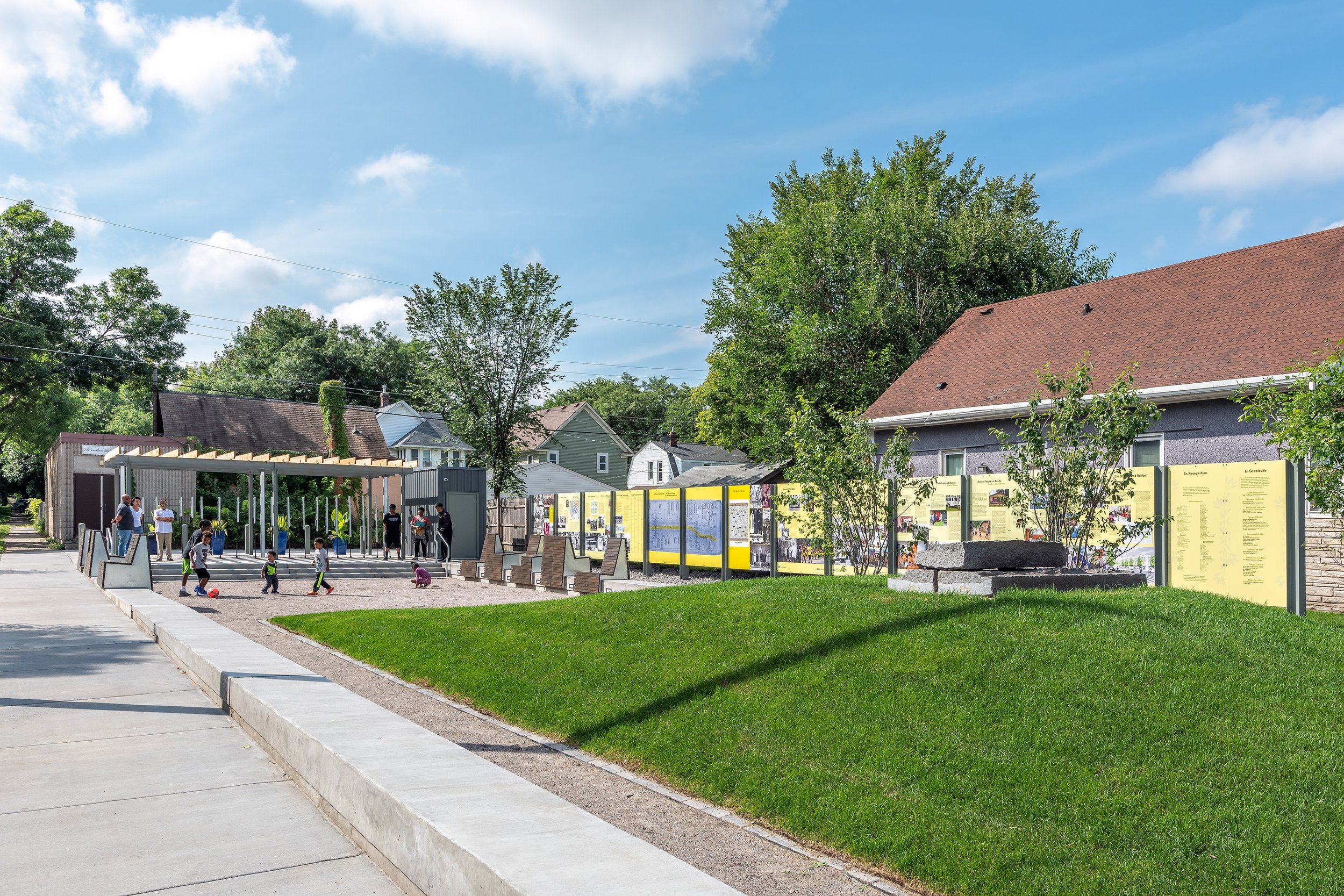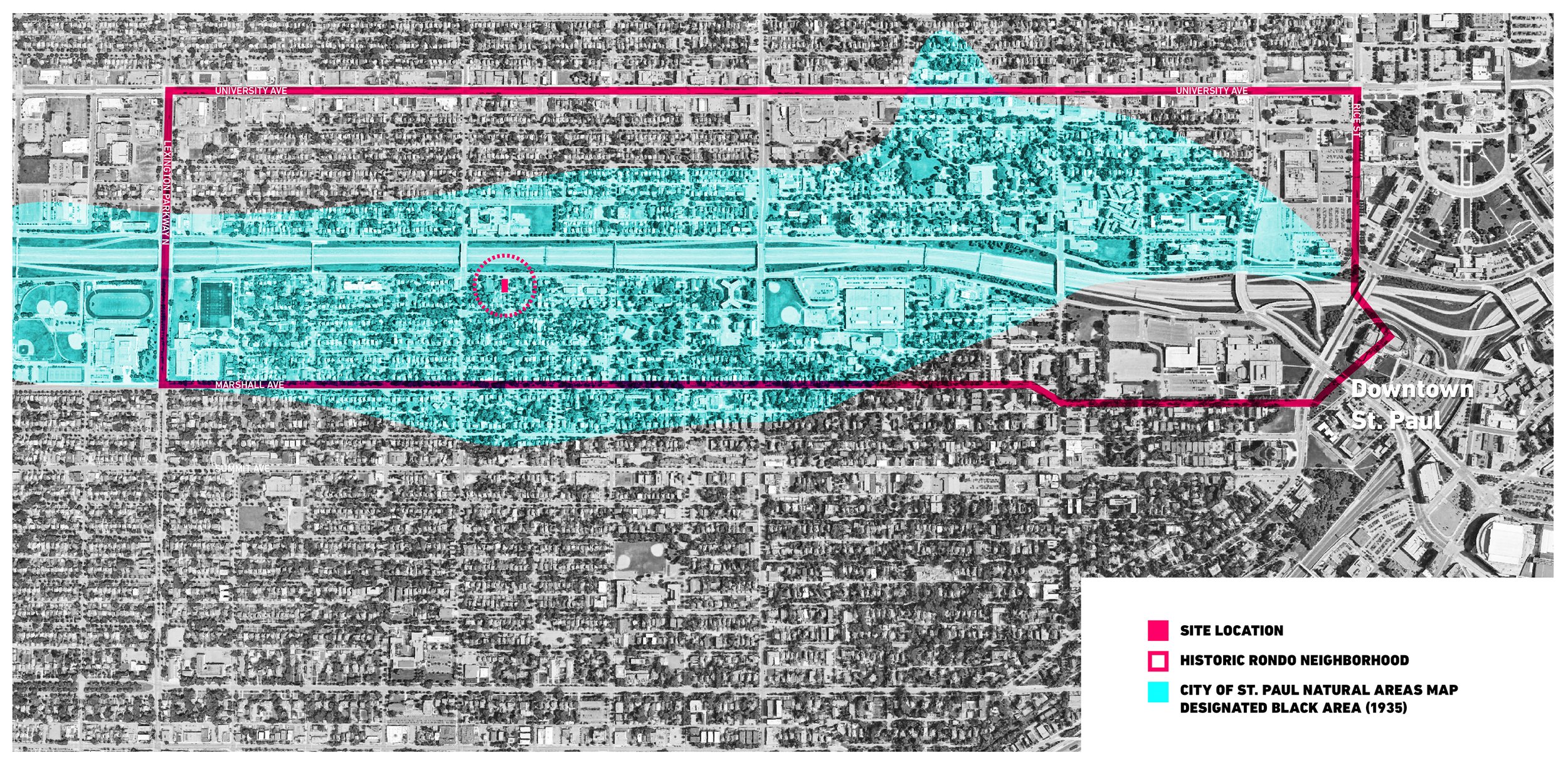RONDO COMMEMORATIVE PLAZA
Location: St. Paul, Minnesota
Client: Rondo Avenue Inc.
Status: Completed in 2018
Area: 4,500 SF
Team: TEN x TEN, 4RM+ULA, Roger Cummings, Seitu Jones
Awards: 2019 ASLA Minnesota Honor Award for General Design, 2019 ASLA Minnesota People’s Choice Award
Slideshow Photos: Morgan Sheff Photography
Rondo Commemorative Plaza is a space that ACKNOWLEDGES the violent deconstruction of St. Paul’s historic and first Black neighborhood Rondo, REMEMBERS the people and places that once resided there and INVITES the whole community to celebrate the future of Rondo. The project was built in partnership and close collaboration within the design team as phase one of a larger vision stewarded by Rondo Avenue Inc. (RAI). The project provides a series of spaces that allow people to gather, reflect, play, perform and learn. The plaza sets a powerful precedent for the capacity of a landscape to reconcile devastating histories while transforming and reimagining the futures of neighborhoods and cities and a movement towards reconciliation and justice.
THE HISTORY OF THE RONDO NEIGHBORHOOD
This map shows the extent of redlined neighborhoods in Minneapolis and St. Paul and the impact of freeway implementation and planning on Black communities in the Twin Cities. The Rondo neighborhood is situated on the east side in St. Paul.
The Rondo neighborhood in St. Paul was the heart of the Black community. By the 1950s, this cohesive and self-sustained hamlet was home to more than 80% of the city’s Black population and a host of businesses and civic organizations. The 1956 Federal Highway Act, authorized construction of 41,000 miles of highways across the U.S. The system targeted underrepresented communities, giving urban planners the opportunity to clean up “slums”, decimating thriving Black communities, reshaping the physical, political, and racial landscape.
Two routes were considered for I-94: an industrial corridor without residences, and another through the Rondo neighborhood. Residents were forced to sell their homes/businesses at a fraction of the property value. Those who refused to leave were met with sledgehammers by police.
In 1980, Rondo Avenue Inc. was established to preserve its legacy and hold an annual community festival. The building and planning of the Rondo Commemorative Plaza involved many local and national stakeholders and built community connections at both scales.
THE DESIGN
Completed in August 2018, the Rondo Commemorative Plaza embodies the resilience of this small urban community, conceived as an outdoor community room with a series of curated spaces for people to gather, reflect, play, perform, and learn. Like many of the properties lost to Interstate-94, the pocket park is the size of a of typical St. Paul residential lot (5,662 SF). The program is manifested through a series of interpretive spaces, each interconnected to tell the story of the past, present, and future of the Rondo Neighborhood.
The design is based on four actions that build the foundation of the Plaza. They include RECORD: Community Chimes, the Walk + Story Wall; CUT: Community Plaza, The Gardens; ELEVATE: The Lookout; and RECOGNIZE: The Beacon.
RECORD: COMMUNITY CHIMES, THE WALK + STORY WALL
The trellis at the south end of the plaza is designed as one of the projects core interpretive features. The structure is raised from the gathering area and in line with the sidewalk along Fisk Street. Under the trellis, an art installation comprised of a series of 18 chimes (representing 18 historic streets) sits on an abstract map of the old Rondo neighborhood, interpreting the barrier that the freeway created and maintains within the community.
The Walk engages all parts of the Plaza starting from the old Rondo Avenue and finishes at the trellis and the map. Along the Walk is a Story Wall where visitors can explore major events in the history of the Rondo neighborhood, it’s settlement and growth; the pre-1960s economic, political, and social development; the destruction of the neighborhood and building of I-94; and the continued growth and success of the community today. Custom benches allow users to engage in gatherings, read the panels, and take in views of downtown. The benches recall the bar stools from the former VFW.
CUT: COMMUNITY PLAZA, THE GARDENS
The Community Plaza is designed to be a multi-functional space that can be programmed by the community in a variety of ways. The space in front of the trellis acts as a stage for artistic and musical performance that can be viewed by an audience in the Plaza. Tables and chairs can be set up for community style games and tournaments or used as a space for social gatherings, music, and dancing. On each side of the Plaza, custom benches allow users to engage in gatherings, read the history panels, and take in views of downtown St. Paul. The Plaza also integrates a stormwater drainage field that captures, holds, and conveys the stormwater for the entire Plaza and adjacent neighbor properties.
Stormwater integration throughout the project facilitates the process of community water collection and filtration. The bio-filtration gardens capture stormwater within the plaza and along Fisk Street for 2 blocks south and along Concordia Avenue (the old Rondo Avenue) for one block east. The Gardens absorb and filter the water with mixed native plantings and clean the rest of the water before it flows into the city’s stormwater system. Close collaboration with the city and the two watersheds were required to execute these strategies. The Gardens received grant funding from both watersheds for implementation with a grant application effort led by the design team.
ELEVATE: THE LOOKOUT
The sculpted hill at the center of the plaza offers a compelling green space to sit, relax, and reflect. At the top of the hill are salvaged granite curbs that recall the historic fabric of St. Paul streets and provide a place of contemplation. Standing atop the hill, one can connect to the old Rondo neighborhood across the freeway and the expanse of the plaza. The hill acts as a sound shield and represents the massive earthwork that was part of the freeway construction.
RECOGNIZE: THE BEACON
The 30-foot-tall marker is a testament to the resiliency of the Rondo community, proudly proclaiming that “we are still here”! It boldly occupies the location of the former building’s main entry and marks the significance of this place to passersby in the neighborhood and along the freeway. The word ‘Rondo’ illuminates the night sky. This Beacon and public space now serve the current residents of the neighborhood as an act of defiance and resilience to the adjacent freeway that once displaced families.
The team expanded the site’s reach by bringing right-of-way into the project. The top looks in at the Plaza with layers of site elements giving the space greater depth. The bottom shows the experience moving through the series of spaces.
Step lights line the Plaza to provide accent lighting and activation. The trellis contains color-changing LEDs that frame the edges and shine in playful contrast with the Chimes. The Beacon is topped with color changing LEDs, reinforcing the Plaza’s presence.
Over the last three years, the project has catalyzed significant change in the neighborhood and city. The Plaza is heavily programmed through the spring, summer and winter with a wide range of community events including hosting a parade stop and large gatherings during Rondo Days, regular music performances, and neighborhood gatherings. The parcel and building to the south was purchased by Rondo Avenue Inc to extend their mission as a cultural center and serves as an event space, and also houses the Rondo Research Collection and museum. The establishment of this new endeavor also founded their commitment to Reconnecting Rondo, a vision for the establishment of a land bridge across the freeway to rebuild the lost neighborhood. After extensive lobbying to the state, they were allocated $6.2 million as part of begin project predevelopment for the creation of a land bridge over I-94 that will establish a new public realm with commercial and residential uses.



























